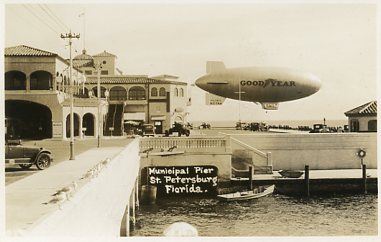Banking on Tourism
As St. Pete moved toward the second decade of the 20th century, many influential leaders “banked on tourism” as the path to prosperity. They pushed for the preservation of “the natural and recreational amenities of the city including the waterfront park system” rather than pursuing an expanded industrial port. When the waterfront was dedicated as a park in 1920, it became clear that tourism had moved to the forefront of the city’s plans for economic prosperity. Efforts to draw people here escalated.
“First Commercial Air Ship Line in World!”
Early enthusiasts promised potential visitors that even though St. Pete was a bit difficult to reach, they would be invigorated by our abundant waters and clear blue skies. Forward-thinking boosters looked to those clear horizons and envisioned new possibilities. They gathered investors and persuaded the city to build a hangar. On Dec. 17, 1913, “the St. Petersburg-Tampa Airboat Line” was launched. It was 10 years to the day after the Wright brothers first flew successfully at Kitty Hawk. Hailed as the birth of commercial aviation, this liftoff was met with high hopes. Throngs of people gathered on both sides of the bay to witness the first scheduled flight from St. Pete, which was met in Tampa with “an enthusiastic cheer.” Twice-daily flights began immediately. One-way tickets for the approximately 20-minute flight sold for $5. In the first weeks, many took advantage of the exciting new venture as passengers and boosters. St. Pete and Tampa newspapers bantered over passenger intentions: Were people “eager to get to Tampa” or “always in a hurry to get away”? Merchants advertised that their wares had been transported via air. The St. Petersburg Times bragged that it delivered its daily edition “as no other” to Tampa. By mid-March, thousands of pounds of cargo and 1,200 passengers had been transported without incident. Despite this auspicious liftoff, however, those original high hopes could not keep the venture aloft. As summer loomed and snowbirds departed, passenger demand sank. Slim profit margins disappeared, and by early May 1914, the nation’s first commercial airline had become history.
A Boom, A Bust, and …
Ten years after the demise of the Airboat Line, St. Pete’s economy was booming. Past failures seemed unimportant in the midst of exciting new expansion. Unfortunately, when the land speculation driving that boom collapsed in 1926, the economy again took a dive. The national economy continued to flourish, however, and tourism returned to the forefront of efforts to keep the city from falling into a deep financial pit. Boosters upped their already considerable efforts to draw people to the city; by 1927, St. Petersburg seemed to be pulling out of its economic dive.

A Blimp
Confidence was high at the December 1927 “Celebration of the Sun.” According to one speaker, “now is the time to buy in this city” as population growth and tourism numbers reached record highs. Roads, bridges, and ferries built during the boom-times helped bring these expanding crowds, and some visionaries once again looked to the skies. Despite the international buzz surrounding Charles Lindbergh’s historic 1927 flight, not everyone was convinced that “heavier than air” methods of flight were the future of passenger service. Others put their hopes on “lighter than air” airships, such as the dirigibles, zeppelins, and blimps that had been the first airships to carry passengers over long distances. Famed city booster John Lodwick claimed that “most of Florida’s travel from the North within the next 10 years will be by this type of aircraft.” He convinced Goodyear-Zeppelin Corp. to choose St. Pete as a southern base of operations. In September 1929, the city authorized funds for a municipal blimp hangar at the newly built Albert Whitted Air Field. Anticipation was high among both citizens and fliers. A local salesman characterized his blimp ride (won in a contest) as “one of the greatest trips he’s ever taken.” Invited as a passenger, Neita Schmidt “thoroughly enjoyed” her inaugural ride. As a “local girl pilot,” she predicted a “thrilling and boundless future” for blimp pilots, lamenting only that women were not yet allowed to “invade this field.” Despite high hopes, financial realities once again poke holes in a lofty dream. The blimp arrived in its new home in January 1930, but the stock market and tourism both had crashed by then. Lodwick’s “Flying Folly” proved no match for the Great Depression and was grounded before it ever had a chance to prove its potential.
Hopes & Follies: St. Pete’s Place in History
Over the next decade, airplane designs improved, and airships remained serious contenders as passenger carriers. Even as an avid airplane pilot, Schmidt raved about the blimp’s advantages, including its “windows” and the “spacious cabin” that was a “model of comfort” for passengers. Just as more communities began considering the benefits of local air travel options, the tragic 1937 crash of the Hindenburg in New Jersey marked the end of the (lighter than air) airship era. St. Pete holds a special place in the foundational history of the competition over the means of commercial flight, thanks to forward-thinking early boosters always looking for new ways to “bank on tourism.”
Sources available on request and include prior research by Nevin D. Sitler.



